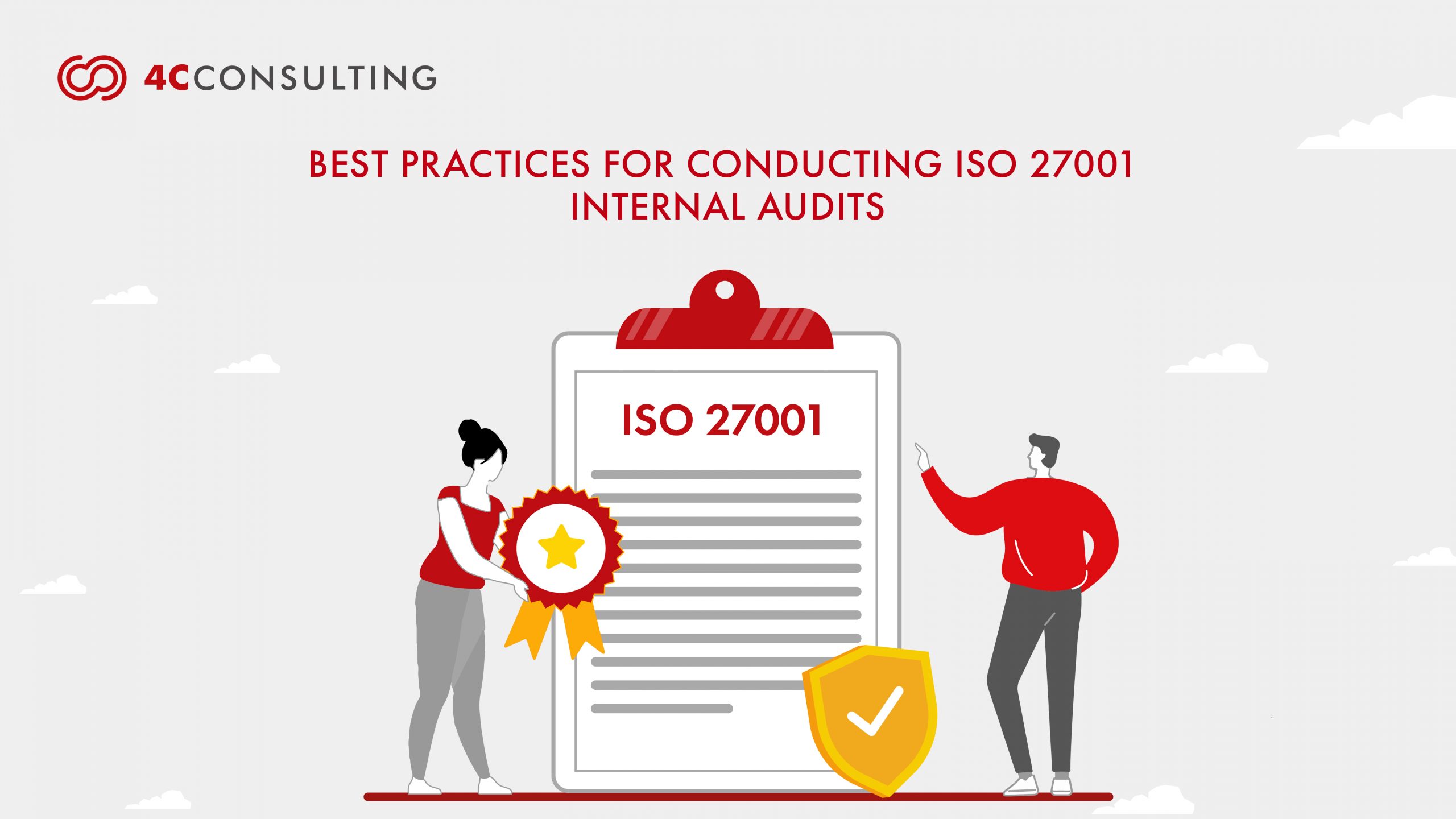
BEST PRACTICES FOR CONDUCTING ISO 27001 INTERNAL AUDITS
5th Oct, 2024
Did you know that 70% of businesses face recurring non-conformities in their ISO 27001 audits due to inefficient internal processes? A well-conducted internal audit is crucial for maintaining compliance with ISO 27001 and protecting sensitive information. Regular internal audits help organizations identify vulnerabilities in their Information Security Management Systems (ISMS) and ensure continuous improvement. This blog will explore the best practices for conducting ISO 27001 internal audits, focusing on the role of audits, key areas to address, and how to handle non-conformities effectively.
.
UNDERSTANDING ISO 27001
ISO 27001 is an international standard that provides a framework for establishing, managing, and improving an ISMS. It helps businesses protect their sensitive data by applying security measures that reduce the risks of data breaches. ISO 27001 certification is essential for organizations that want to show their clients and stakeholders that they take data protection seriously. This certification applies to all types of businesses, regardless of size or industry, and helps in strengthening both security and trust.
.
Enhance ISMS Performance with Effective ISO 27001 Internal Audits.
.
THE ROLE OF INTERNAL AUDITS IN ISO 27001 CERTIFICATION
Internal audits are important to ensure that your ISMS meets the requirements of ISO 27001. These audits allow an independent review of your system, helping to ensure that the necessary security measures are in place and working effectively. Regular audits not only highlight areas of non-compliance but also provide opportunities for continuous improvement. A well-conducted audit can prepare your organization for a smooth external audit, ensuring that you remain compliant with ISO 27001 requirements. Key areas to cover during an internal audit include risk management, employee awareness, access control, and how well your organization responds to security incidents. By focusing on these areas, you can ensure that your ISMS stays aligned with the standard.
.
KEY AREAS TO FOCUS ON DURING ISO 27001 INTERNAL AUDITS
- Risk Management Procedures: One of the most important aspects of ISO 27001 is managing security risks. Internal auditors need to review the organization’s risk assessments to ensure they are up to date and that proper measures have been taken to control these risks. Auditors should also verify that risk assessments are regularly revisited to adapt to evolving security threats.
- Access Control Systems: Auditors should check whether access to important data is restricted to authorized personnel only. This includes verifying that access controls, such as password policies and multi-factor authentication, are in place and being followed. Regular reviews should ensure that access rights remain appropriate as roles or personnel change.
- Information Security Policies: All security policies must be well-documented and consistently communicated across the organization. Auditors must review whether these policies are applied correctly and regularly. It is also essential to confirm that these policies are updated periodically to reflect new security challenges or regulatory changes.
- Incident Management Process: It’s important to evaluate how past security incidents were handled and whether the organization has learned from these incidents to prevent future occurrences. This step ensures that a proper response plan is in place. Additionally, auditors should check if lessons from incidents have been incorporated into preventive strategies.
- Employee Training and Awareness: Employees must be aware of their responsibilities regarding information security. Regular ISO 27001 training should be provided to ensure that employees understand their roles in maintaining compliance. Auditors should assess whether training is conducted at appropriate intervals and updated based on any new risks or compliance requirements.
- Regular Monitoring and Reviews: Continuous monitoring of the ISMS helps identify any gaps or areas that require improvement. Internal audits should ensure that regular reviews of security policies, procedures, and controls are taking place. Monitoring should be complemented with timely corrective actions to address any non-conformities.
- Physical Security Measures: Internal audits should also focus on the physical security of data storage systems, ensuring that physical access to sensitive information is appropriately restricted. Auditors must verify if access logs are maintained and reviewed regularly to detect any unauthorized access attempts.
- Third-Party Vendor Management: Internal Auditors should also examine the organization’s relationships with third-party vendors and service providers, as these can be potential sources of security risks. Ensure that vendors comply with the organization’s security policies and that proper agreements, such as Service Level Agreements (SLAs) and Non-Disclosure Agreements (NDAs), are in place to protect sensitive information.
- Data Encryption and Backup Procedures: A key area of focus is whether the organization’s data is encrypted during storage and transmission to safeguard against unauthorized access. Auditors should also review the organization’s data backup procedures to ensure that critical information can be recovered in the event of data loss or a security breach. Regular testing of backup systems should be verified to confirm their reliability.
.
MANAGING NON-CONFORMITIES DURING ISO 27001 INTERNAL AUDITS
Non-conformities occur when the actual implementation of the ISMS does not match the requirements of the ISO 27001 standard. Handling these effectively is essential for continuous improvement and compliance. Proper management of non-conformities helps organizations ensure that vulnerabilities are addressed before they lead to more significant security risks.
- Identifying and Classifying Non-Conformities: Non-conformities can be classified as either major or minor. A major non-conformity could significantly impact information security, while a minor non-conformity might involve smaller, isolated issues. Auditors must ensure that all non-conformities are identified accurately, and their severity is evaluated based on the potential risk to the ISMS.
- Documenting the Non-Conformity: It is essential to record every non-conformity found during the audit. This should include details about what went wrong, why it’s a risk, and which part of the ISO 27001 standard was not followed. Documentation should also specify the potential impact of the non-conformity on the organization’s overall information security.
- Conducting Root Cause Analysis: For every non-conformity, it is important to identify the root cause of the issue. This ensures that the problem is addressed at its core and doesn’t happen again. A thorough root cause analysis helps prevent recurring issues and strengthens the ISMS by addressing systemic flaws.
- Developing Corrective Action Plans: After identifying the root cause, a corrective action plan should be created. This plan should outline the steps required to address the non-conformity, assign responsibilities, and set deadlines. A well-structured corrective action plan ensures that issues are resolved promptly and effectively, minimizing risks to the organization’s information security.
- Follow-Up and Verification: After the corrective actions have been implemented, the auditor should verify that the issue has been properly resolved. This may involve conducting follow-up audits to ensure that the changes have been successfully embedded into the ISMS. Continuous verification of corrective actions ensures that the organization remains compliant and prevents the same non-conformities from reoccurring.
- Communicating Findings with Stakeholders: It is crucial to communicate non-conformities and their potential impact to relevant stakeholders, including management and key decision-makers. Transparency ensures that leadership understands the risks involved and can support the corrective actions necessary to address these issues. This step also fosters a culture of accountability and continuous improvement.
- Learning from Previous Internal Audits: Internal auditors should assess whether previous audits and identified non-conformities have been effectively resolved and whether the lessons learned have been integrated into the organization’s ISMS. By addressing past mistakes, organizations can proactively fortify their systems, significantly reducing the chances of recurring issues. Regularly reviewing and reflecting on past non-conformities also creates a solid benchmark for tracking continuous improvements and ensuring a more robust security posture moving forward
Regular ISO 27001 internal audits are essential for maintaining the effectiveness and compliance of an organization’s Information Security Management System (ISMS). These audits help identify vulnerabilities, ensure adherence to ISO 27001 standards, and promote continuous improvement. By focusing on critical areas such as risk management, access control, and incident handling, internal audits strengthen an organization’s overall security posture. Effectively managing non-conformities through proper documentation, root cause analysis, and corrective actions helps prevent recurring issues, ensuring the ISMS remains robust. Additionally, involving stakeholders and learning from past non-conformities fosters a culture of accountability and improvement, safeguarding sensitive information and reinforcing trust with customers and regulatory bodies.
.
HOW 4C CAN HELP YOUR ORGANIZATION GET ISO 27001 CERTIFICATION?
To help organizations gain credibility and trust from clients, employees as well as stakeholders and avail the numerous benefits of ISO 27001, 4C experts help in complete ISO 27001 implementation. We provide ISO 27001 Training as well as consulting to help you strengthen your ISMS. Team 4C consists of IRCA certified 27001 auditors who have 15+ years of experience. Having provided consulting services, risk assessment and BCP documents to 100+ for IT and ITES companies; we have empowered companies to enhance profitability as well as credibility across the globe. Also, we have provided 5000+ hours of training on IT Security Management System (ISMS) to help them gain benefits continually. To incorporate ISO standards and implement ISO 27001 in your organization, contact us now.



